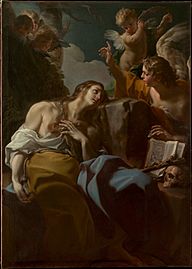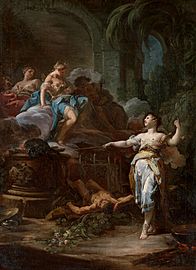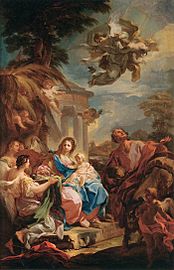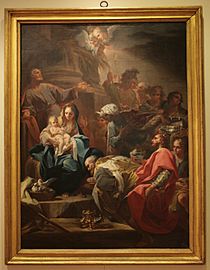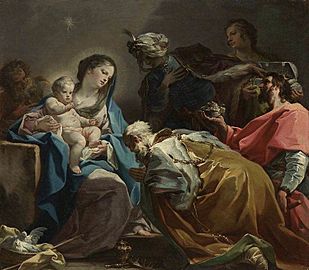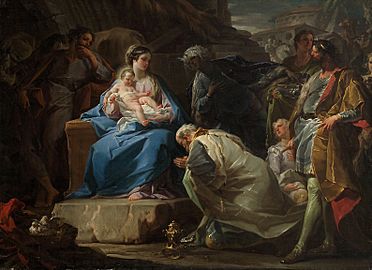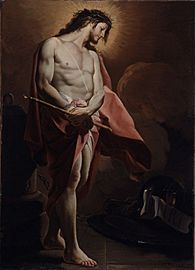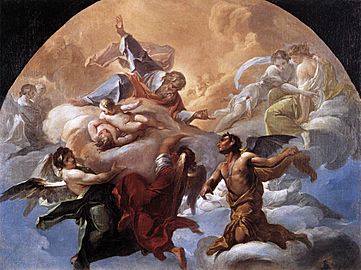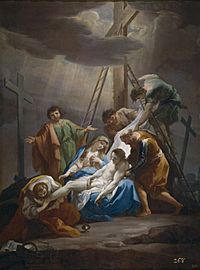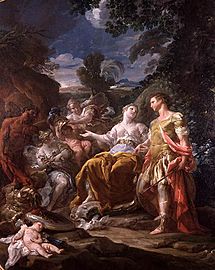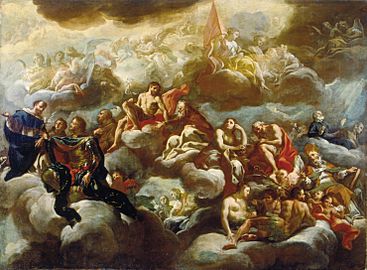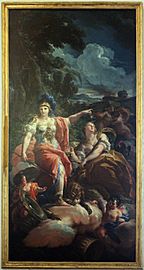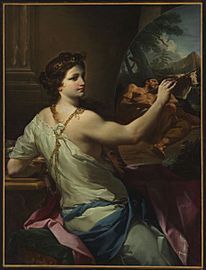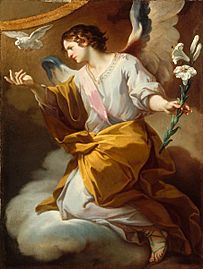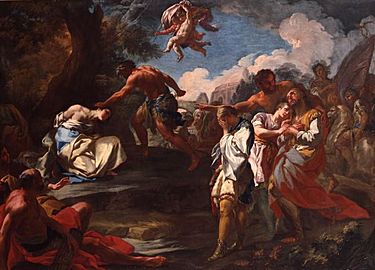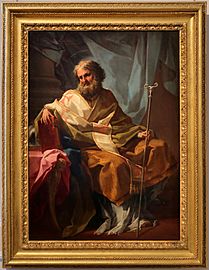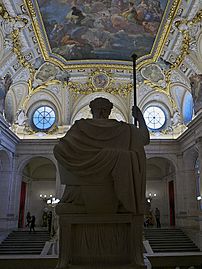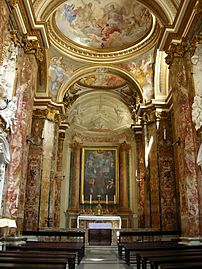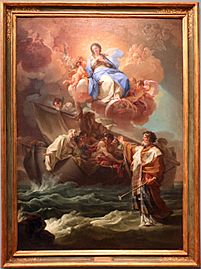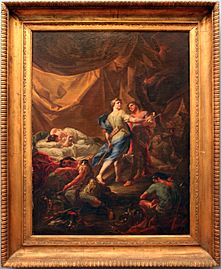Corrado Giaquinto facts for kids
Corrado Giaquinto (born February 8, 1703 – died April 18, 1766) was a talented Italian painter from the Rococo art period. Rococo art is known for being light, graceful, and often playful, with lots of fancy details. Giaquinto traveled a lot and painted beautiful artworks for kings, churches, and important people across Europe.
Contents
Becoming an Artist
Corrado Giaquinto was born in a town called Molfetta, Italy. When he was a boy, his parents wanted him to have a religious career, but Corrado was much more interested in art. He started learning to paint with a local artist named Saverio Porta.
By October 1724, he left Molfetta. He then trained in the busy art studio of Francesco Solimena in Naples. Many famous artists of that time, like Francesco de Mura and Giuseppe Bonito, also learned there.
Moving to Rome and Big Projects
In 1723, Giaquinto moved to Rome to work with another well-known painter, Sebastiano Conca. He painted in several churches in Rome, including San Lorenzo in Damaso and San Giovanni Calibita. He also painted a ceiling at Santa Croce in Gerusalemme.
In March 1727, Giaquinto opened his own art studio in Rome. In 1734, he got married to Caterina Silvestri Agate.
One of his first big projects was in 1730. He was asked by King John V of Portugal to paint Christ crucified with the Madonna, Saint John Evangelist, and Magdalene for the Mafra National Palace.
In 1731, he received an important job to paint frescoes (paintings on wet plaster) in the church of San Nicola dei Lorenesi. He painted scenes like Saint Nicholas water gush from cliff and a large painting of Paradise in the dome. These works showed that Giaquinto was developing his own unique style.
Important Works and Travels
In 1733, a famous architect named Filippo Juvarra invited Giaquinto to Turin. There, Giaquinto painted an altarpiece (a painting behind an altar) of Saint John Nepomuk. He also decorated the ceiling of a grand house called Villa della Regina with paintings like a Triumph of the House of Savoy and stories from Greek myths such as Death of Adonis and Apollo & Daphne.
Giaquinto went back to Rome briefly in 1735, where his wife sadly passed away. He then returned to Turin for three more years. During this time, he finished frescoes for the chapel of St Joseph in the church of Santa Teresa, Turin. These paintings showed important moments from the life of Saint Joseph.
In 1738, Giaquinto was back in Rome. The next year, he painted a fresco called Assumption of the Virgin for a church in Rocca di Papa.
In 1740, Giaquinto became a member of the Academy of Saint Luke, which was a very respected art academy. He also painted a canvas called Immaculate Conception with Elias the prophet for a church in Turin. In 1742, Pope Benedict XIV visited a church that Giaquinto had helped restore and was very pleased with his work.
Working for the King of Spain
Later, Giaquinto moved to Madrid, Spain, where he was supported by King Ferdinand VI of Spain. He became the director of the Academy of San Fernando, a major art school in Spain. His style influenced many Spanish painters, including famous artists like Francisco Goya.
Giaquinto returned to Naples in 1762 to decorate a royal monastery. He passed away in Naples in 1766. One of his students in Molfetta was Niccoló Porta.
Gallery
-
The Penitent Magdalen, around 1750, Metropolitan Museum of Art, New York
-
Medea Rejuvenating Aeson, 1760, Metropolitan Museum of Art, New York
-
Rest on the Flight into Egypt, 1740–1742, Louvre Museum, Paris
-
Adoration of the Magi, 1725, Museum of Fine Arts, Boston
-
Adoration of the Magi, 1740–45, Kunsthistorisches Museum, Vienna
-
Satan before the Lord, 1750, Vatican Museums
-
St. Michael and the devil, 1735, Vatican Museums
-
The Deposition, 1760, Museo del Prado, Madrid
-
Venus Presenting Arms to Aeneas, 1750, Bowes Museum, Barnard Castle
-
The Virgin presents Saint Helena and Constantine to the Trinity, 1741–42, Saint Louis Art Museum
-
Rest on the flight to Egypt, 1764–65, Detroit Institute of Arts
-
Apotheosis of St. Nicholas, 1733, Museu Nacional de Belas Artes, Rio de Janeiro
-
Allegory of fortress and vigilance, Royal Palace of Caserta
-
Martyrdom of Saints Marius, Martha, Audifax and Abacus, 1750, Musée Fesch, Ajaccio
-
The Birth of the Sun and the Triumph of Bacchus, 1762–1763, fresco, Royal Palace of Madrid
-
The Spanish monarchy that pays homage to Religion, Giaquinto's fresco above the staircase Royal Palace of Madrid
-
Interior of the church with frescoes by Corrado Giaquinto, 1731, San Nicola dei Lorenesi, Rome
-
Allegories of Justice and Peace,1754, version for the Real Academia de Bellas Artes de San Fernando, Madrid.
See also
 In Spanish: Corrado Giaquinto para niños
In Spanish: Corrado Giaquinto para niños



